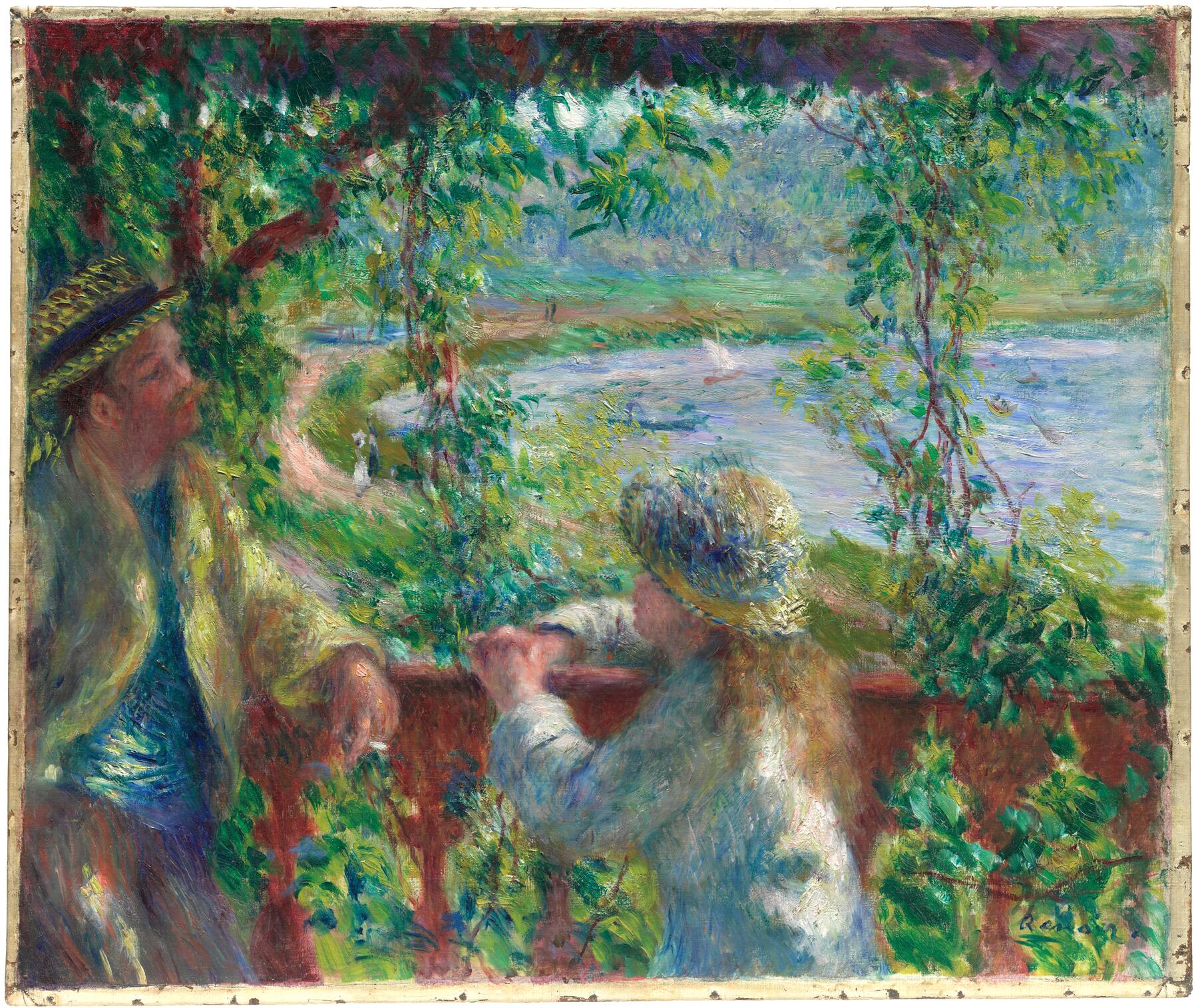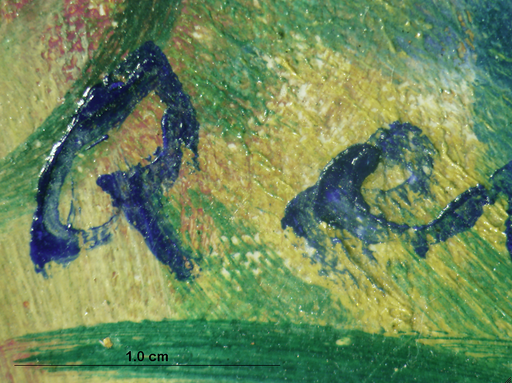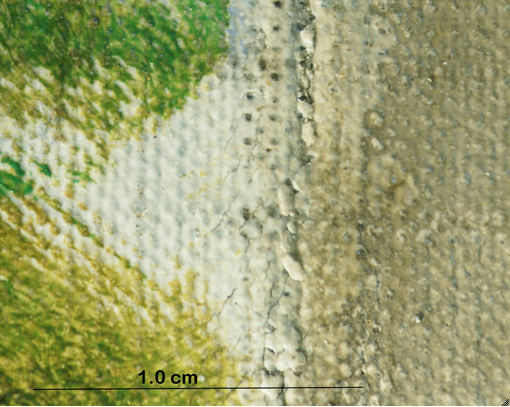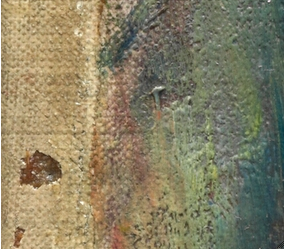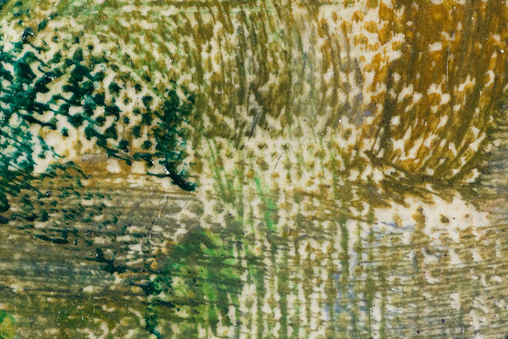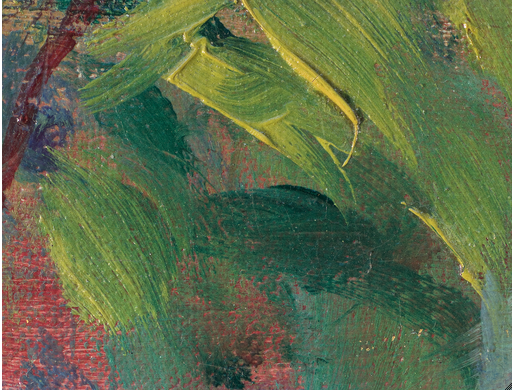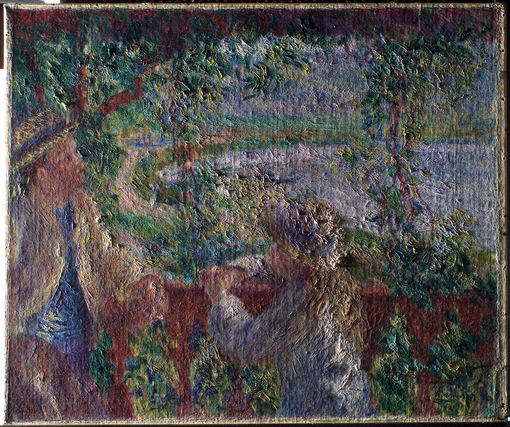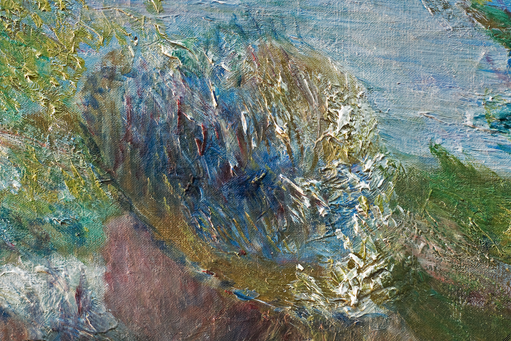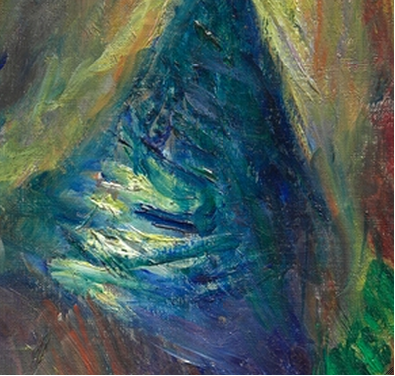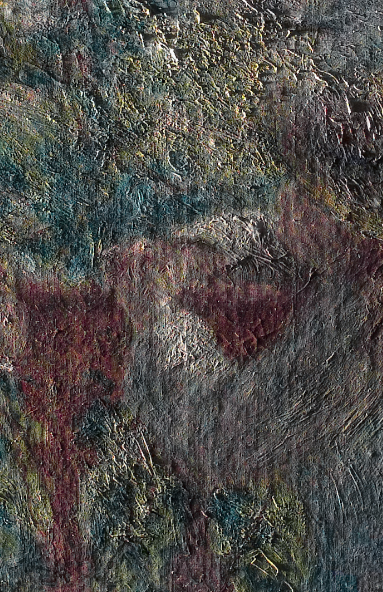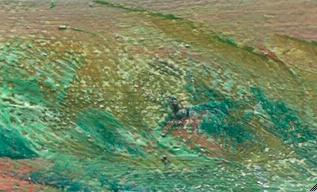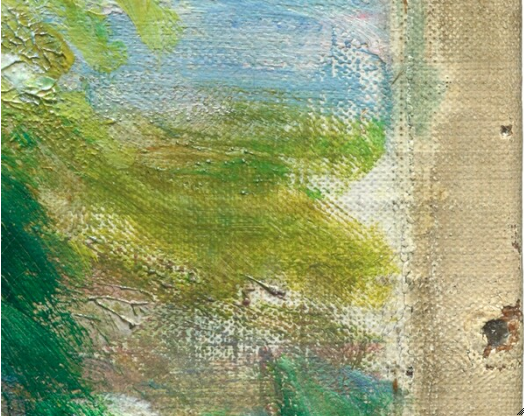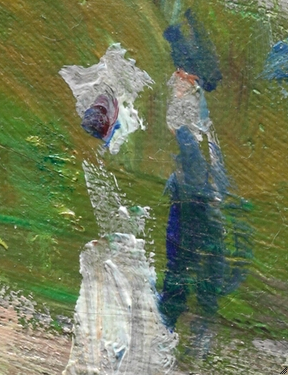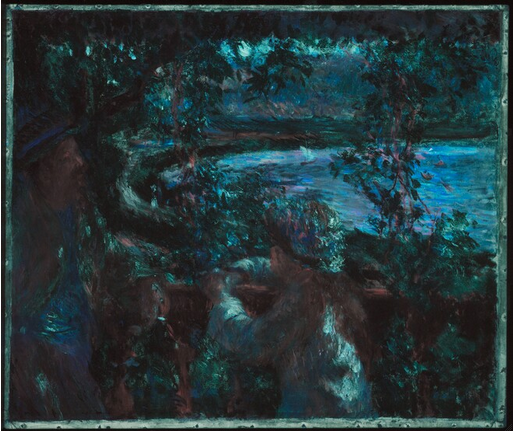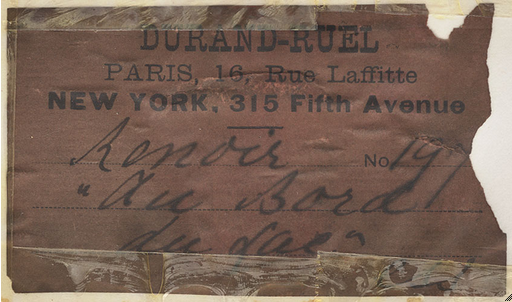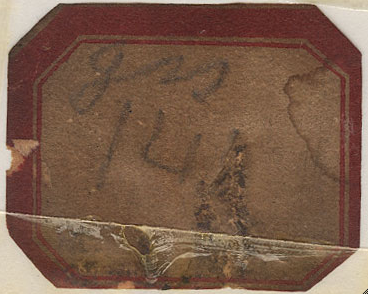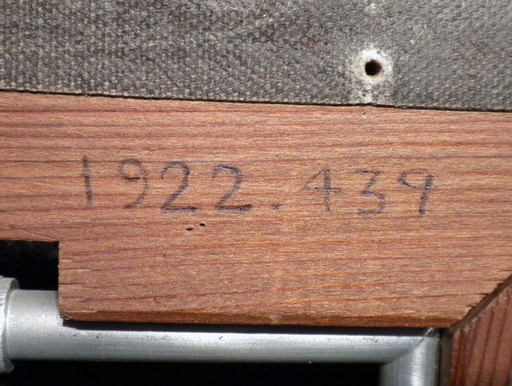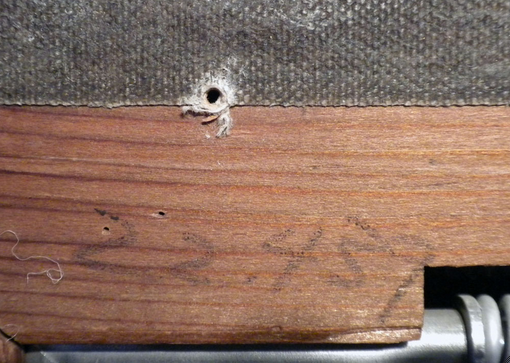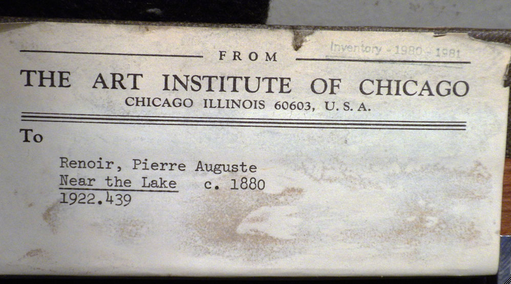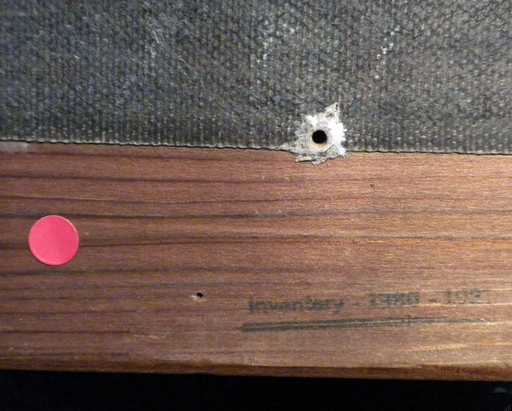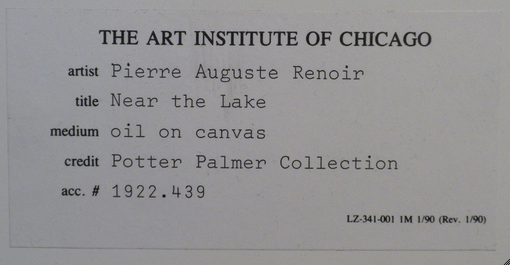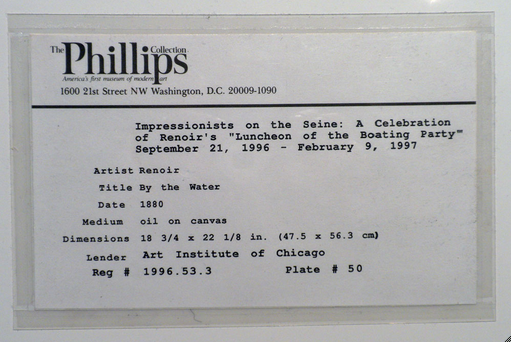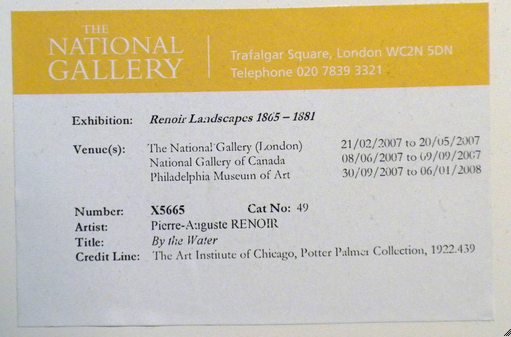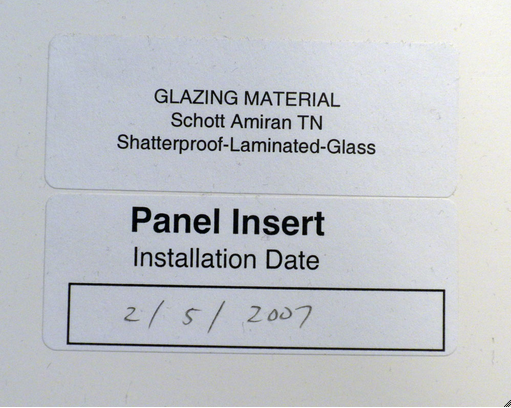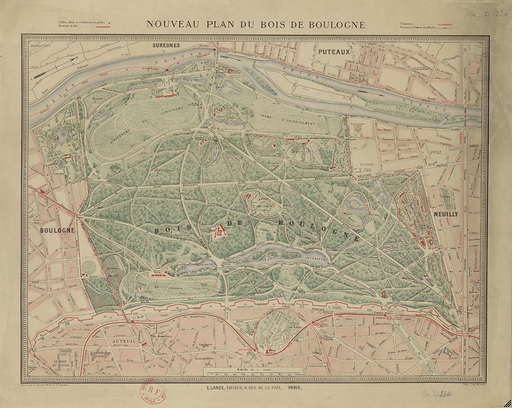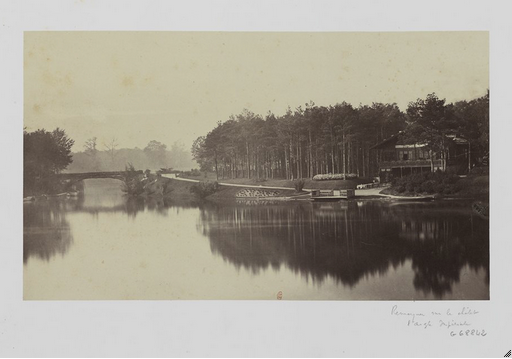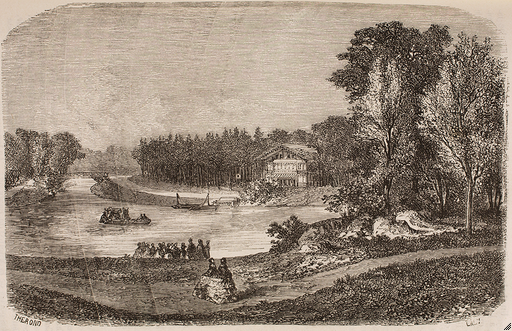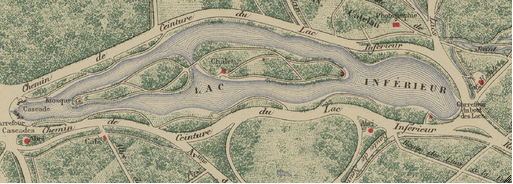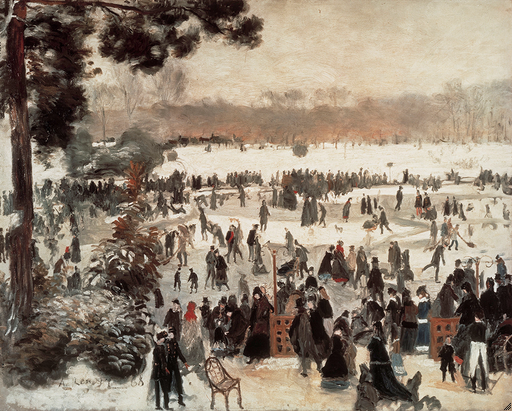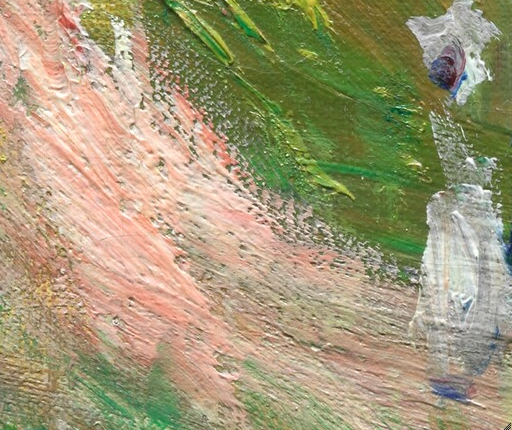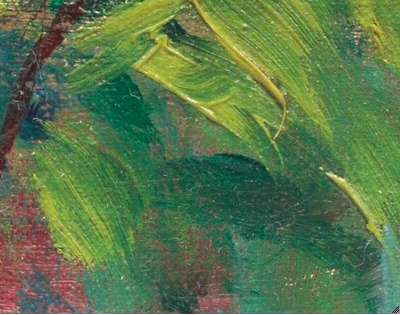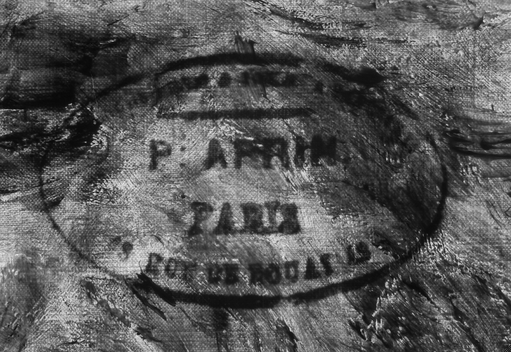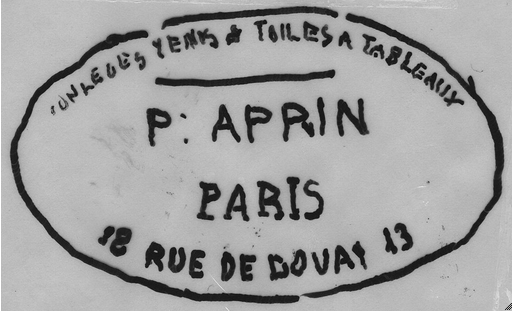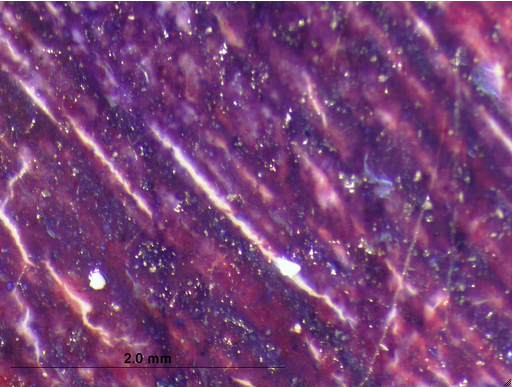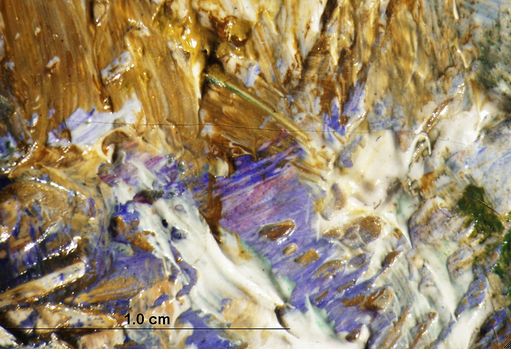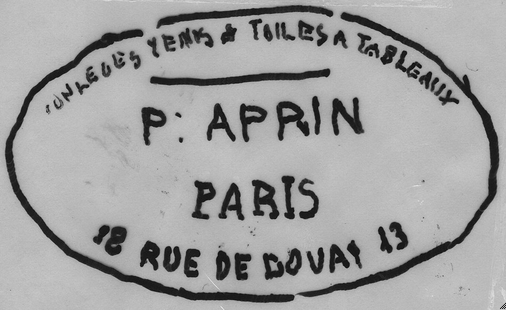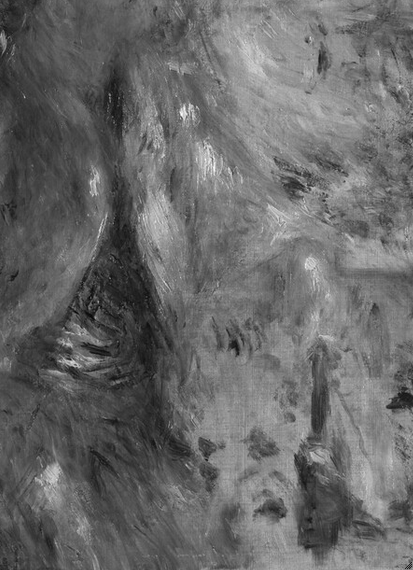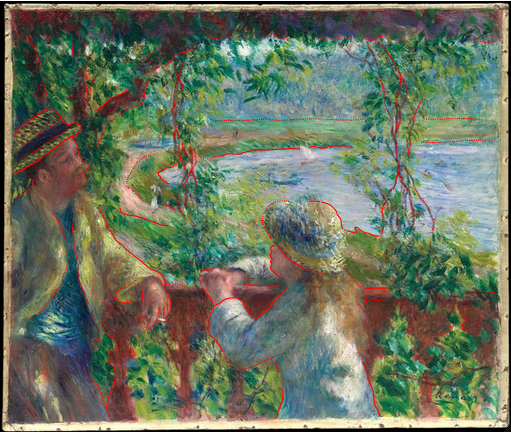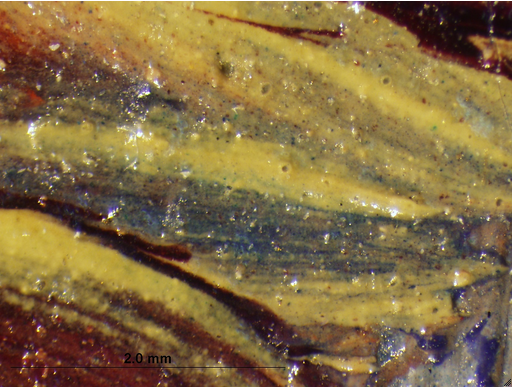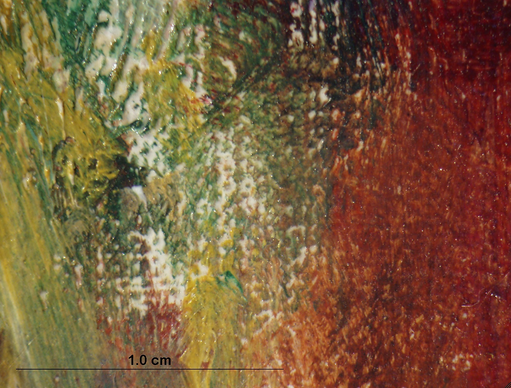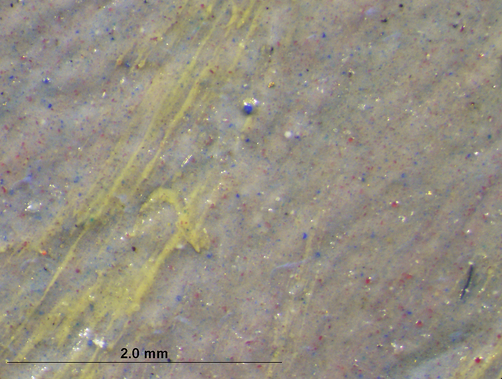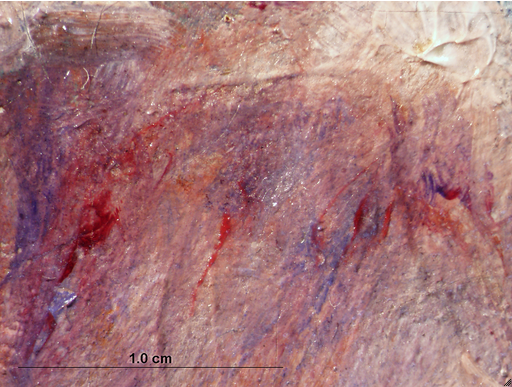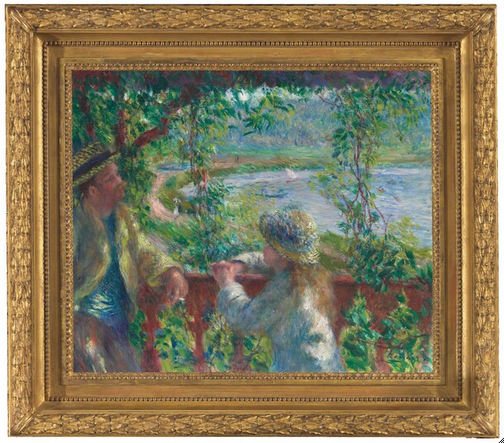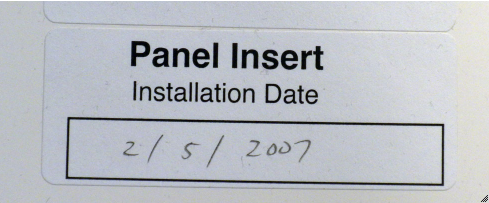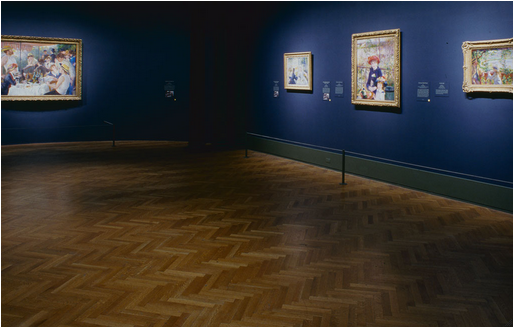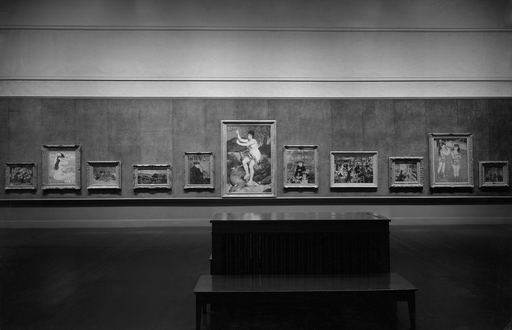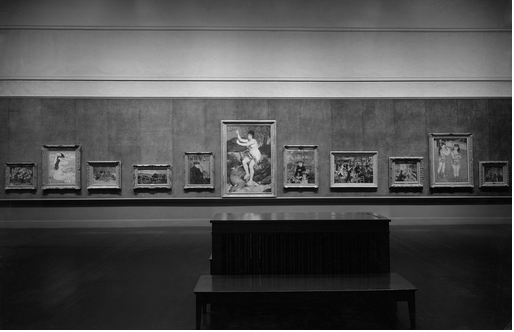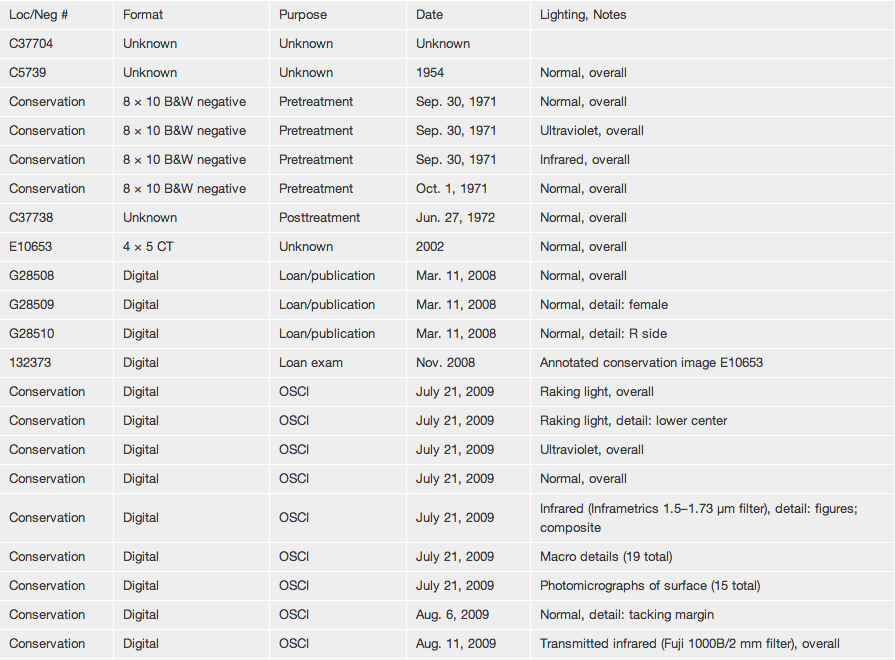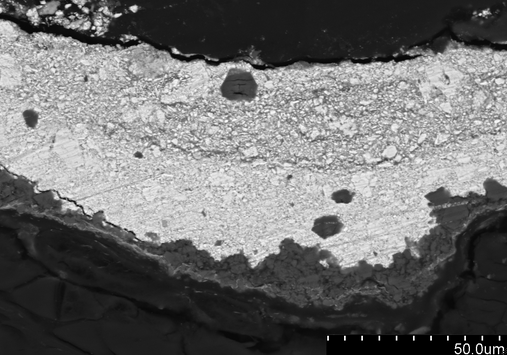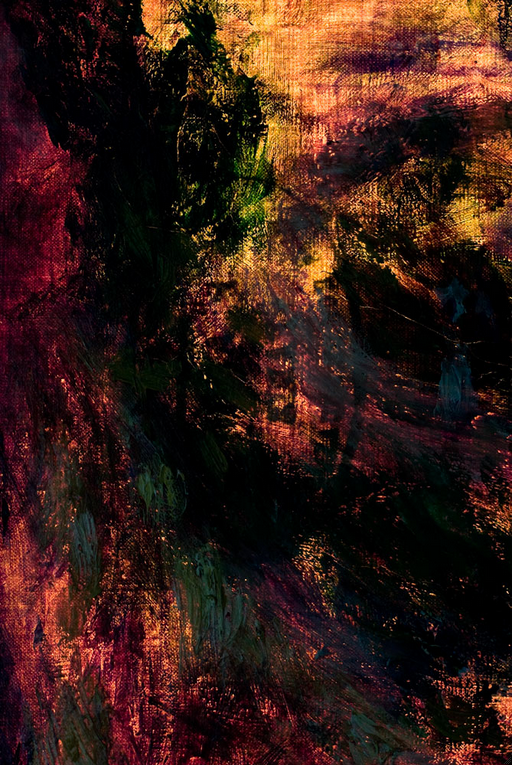Cat. 10
Near the Lake
1879/80
Oil on canvas; 47.5 × 56.4 cm (18 11/16 × 22 3/16 in.)
Signed: Renoir. (lower right, in blue paint)
The Art Institute of Chicago, Potter Palmer Collection, 1922.439
A man in a yellow jacket and loose-fitting brown flannel pants takes a moment to linger over a cigarette in the shade, while a young girl in his care leans toward him, her lips parted in conversation. She is restless to his calm, earnestly intent to his contemplative. The casual dress of the male figure—his collarless blue shirt and straw boater hat—identifies him with the canotier, the rowing sportsman whom Renoir depicted frequently from 1875 to 1883, though in this context it may simply reflect a fashion trend. The man’s red moustache and round face are features shared with Alphonse Fournaise, son of the owner of the Restaurant Fournaise on the Île de Chiard, who also modeled for Renoir’s Luncheon of the Boating Party (1880/81; Phillips Collection, Washington, D.C. [Daulte 379; Dauberville 224]). The presence of the child distinguishes Near the Lake from that celebrated image of boating and from the earlier Lunch at the Restaurant Fournaise (cat. 2), both of which depict the restaurant occupied only by adults. What is the relationship between the two figures in Near the Lake? The girl’s animated interaction with her companion suggests that he is her father or at least a close family member. In Renoir’s work, children are rarely unrelated to the theme; if he places them in a setting, it is undoubtedly because they belong there. Most often children conjure a joyfulness and timeless innocence that enhance the sense of well-being inherent in his luminous Impressionist style. His major genre painting of 1876, Dance at the Moulin de la Galette (fig. 10.1 [Daulte 209; Dauberville 211]), is a good example of how the presence of a child, seen playing with her mother on the lower left, completely transforms a disreputable Montmartre dance hall into a gathering place for community and family. In the case of Near the Lake, the girl, who is located in the center of the composition and wears a fanciful hat decorated with flowers and perhaps blue feathers, contributes enormously to the idyllic mood of the scene. By including children in adult situations without making them appear coy or out of place, Renoir may have been following the example of the French eighteenth-century painter of pastoral scenes, Jean-Antoine Watteau.
The Question of the Lake
While the man wears the costume of a canotier and bears a resemblance to Alphonse Fournaise, the setting for this painting is not the Seine at Chatou. The work was described as depicting a lake throughout its long history of ownership during Renoir’s lifetime. It was acquired as Au bord du lac by Durand-Ruel, Paris, on September 24, 1886, and exhibited in New York the next year as Near the Lake. Indeed, the wooden balustrade against which the figures lean and the low-hanging roof above them are typical of the gazebo or kiosk architecture commonly found near lakes in French municipal parks in the nineteenth century. The decorative design of the balustrade is echoed in the two scrolled brackets on either side of a vertical support post behind the man’s left shoulder. Which park and lake are represented have, however, never been identified. One possibility is Lake Enghien, which is a few miles from Argenteuil, where Claude Monet lived from 1871 until 1878. Yet Renoir is not known to have visited Lake Enghien, and by 1886 the hotels and rental houses of Enghien-les-Bains lined the shores of the lake, limiting its potential for the landscape view seen here.
A more likely candidate for the setting is the Bois de Boulogne, a park consisting of crown lands given to the City of Paris in 1852 by Napoleon III. Despite heavy bombardment during the Prussian siege in 1870, it remains a wooded refuge from the city to this day (fig. 10.2). The path by the shoreline of Near the Lake appears to be finished in crushed pink granite, suggesting a level of maintenance that would only be found in a park. Renoir added the path, the figures walking along it, and the boats in the background in the final stages of painting. The unkempt wildness of the tangled vines that hang from the kiosk roof lends a note of rusticity to an otherwise well-manicured landscape. The vines were painted primarily in red over the dried layers of blue and white that make up the water. A desire to suggest the densely wooded setting of Bois de Boulogne parkland might explain why Renoir elevated the tree line beyond the lake so that only a thin band of cloudy sky remains. The more extensive cloud cover can be seen in the top half of the [glossary:X-ray] (fig. 10.3; see Application/technique and artist’s revisions in the technical report). Visible in the infrared image is an object in the left hand of the male figure, possibly a bottle or an umbrella handle, either of which would be appropriate in a public park close to the city when rain was expected or where refreshments were offered (fig. 10.4). Renoir presumably painted this object out because the partial representation read awkwardly.
There are two large lakes in the Bois de Boulogne, the lac Inférieur or Lower Lake and the lac Supérieur or Upper Lake, which have undergone numerous changes in landscaping over the years. Period photographs and illustrations of the chalet built on the island of the Lower Lake reveal that it was originally constructed in an architectural style that incorporated ornamental wooden balustrades and low-hanging eaves of the kind we see in Near the Lake (fig. 10.5, fig. 10.6). The elevation from the terrace of the chalet offers views of the lake and the paths around it that correspond to the raised point of view suggested in the painting, though not precisely to the curved shoreline that Renoir has placed in the background. A curious structure labeled “Photographie” at the north end of the Lower Lake on a period map (fig. 10.7), however, does offer a view that corresponds to the curved shoreline of Near the Lake. No further documentation of this building has yet emerged.
Renoir had earlier made the Bois de Boulogne the subject of at least two paintings. A rare winter scene by the artist, Skaters in the Bois de Boulogne (fig. 10.8 [Dauberville 110]), depicts a snow-covered landscape and crowds of Parisian adults and children enjoying the frozen surface of a lake, probably the Lac pour le patinage (Skating Lake), a small artificial lake in the north part of the Bois. The park is also featured in the largest painting Renoir ever made, Riding in the Bois de Boulogne (fig. 10.9 [Daulte 94; Dauberville 247]), intended for the 1873 Salon but relegated to the exhibit of réfusés that year. Again the theme is leisure activity involving all ages. A fictional mother and son, modeled by relations of Renoir’s friends—Henriette Darras, wife of Captain Paul-Édouard-Alfred Darras, and thirteen-year-old Joseph Le Coeur (in contrast with the adult male and young girl in Near the Lake)—guide their mounts by one of the park’s two lakes, which offered shoreline promenades.
As Robert Herbert has pointed out, the picturesque and bucolic scenery of the Bois de Boulogne was in fact a deception; the previously forested land had been transformed into its parklike state for the enjoyment of the citizens of Paris on the model of London’s Hyde Park, which Napoleon III had admired. Its vast public spaces were carefully planned and engineered to resemble the countryside. For example, the porous ground underneath the site of the Lower Lake necessitated that the lake be lined with concrete in order to hold water. The Bois de Boulogne thus offered an inviting retreat to an idealized, constructed version of nature. Such a controlled landscape might seem inimical to the Impressionist endeavor to seek out authentic views of nature. But Renoir, by deliberately focusing on an unidentifiable part of the park, was able both to depict the Bois and, by extension, modern Paris, and to suggest a rural environment. Moreover, the Impressionists did frequent the park, for it was as much a part of the experience of Paris as the bustling railway stations and the boulevards of Georges-Eugène Haussmann. Situated near the sixteenth arrondissement, the Bois was easily accessible to such artists as Berthe Morisot, who grew up in the adjacent neighborhood of Passy and built a home in the arrondissement with her husband, which they moved into early in 1883. Prior to that she had found inspiration in the park for her views of women at leisure, such as Le lac du Bois de Boulogne (exhibited at the fifth Impressionist exhibition in 1880 and likely the painting now in the National Gallery, London; see fig. 10.10). Renoir himself also lived in the sixteenth arrondissement for a short time. He listed his address as the avenue d’Eylau (now avenue Victor Hugo) when he exhibited at the Salon of 1865. His friend and fellow artist Alfred Sisley rented an apartment on the avenue de Neuilly near Porte Maillot at the northeast end of the park in 1864.
Renoir’s Brush, Irregularity, and the Meaning of la Tache
Near the Lake was painted on a comparatively small, no. 10 portrait ([glossary:figure]) standard-size canvas. Renoir applied paint generously, often mixing color directly on the canvas, for instance, combining red and white for the pink path by the shore, and mixing yellow and green to create a lighter shade of green for the leaves (fig. 10.11, fig. 10.12). The brushwork reflects a high-energy, focused style of execution. Renoir worked with assurance and lyrical randomness as he explored the expressive potential of la tache (literally, “the touch”), a word used in the nineteenth century to describe visible brushwork in a painting and linked with a long-standing and widely known controversy surrounding progressive art. La tache was considered a characteristic of preparatory sketches, which tended to have a surface appearance thought unsuitable for finished works of art intended for exhibition. This “sketch” aesthetic was closely identified with the Impressionist movement. At the time of his retrospective exhibition in 1883, Renoir was seen by critics as the prototypical artist who painted using la tache: “His eye sees nothing but la tache, the famous tache that plays such a big role today.” Renoir’s touch is everywhere evident in Near the Lake.
The appearance of la tache in Near the Lake foreshadows Renoir’s theory of irregularity, which emphasized that nature was not ideal but rather composed of an infinite variety of anomalies, and assigned a greater value to the imperfections of the handmade than to the geometrical precision of the machine-made. As Renoir articulated in a letter to his art dealer, Paul Durand-Ruel, in May 1884, “The two eyes of the most beautiful face will always be slightly dissimilar; no nose is ever found exactly above the middle of the mouth; the sections of an orange, the leaves of a tree, the petals of a flower are never identical; it seems even that the beauties of every species draw their charm from this diversity.” At that time, the artist had been drafting notes for about a year regarding a group that he called a “Société des Irrégularistes”: “Its aim will be to organize as soon as possible some exhibitions whose participants would be all the artists, painters, decorators, architects, goldsmiths, silversmiths, embroiderers, etc. . . . , who have irregularity as their esthetic principle.”
Renoir’s own work presumably demonstrated how irregularity manifested itself in painting. Details in Near the Lake suggest that he relished the physicality of paint application and the mark of a loaded brush. The textural contrasts he achieved verge on the sculptural. The rendition of the girl’s hat provides an excellent case study of Renoir’s technique (fig. 10.13). The white highlights at the rear of the hat consist of such thick impasto that they might almost have been applied directly from the tube, with a minimum of subsequent brushwork. Parts of the girl’s smock, however, reflect a more fluid, thin layering of glazes, with wisps of yellow added for the hair over almost dry paint (fig. 10.14). Areas of vivid, wet-in-wet brushwork, where colors were blended directly on the canvas so that they appear swirled together, are typical of Renoir’s painting method in the 1870s, evident in works such as At the Theatre (1876–77; National Gallery, London [Daulte 182; Dauberville 232]) and Young Woman Sewing (cat. 7), among many others. Further wet-in-wet paint application can be seen in the man’s face, coat, and trousers, where Renoir was particularly concerned with subduing the tones to suggest shade.
The formidable range of textures evident in Near the Lake was accomplished with the use of a wide variety of brushes and application methods. One of the intriguing characteristics of Renoir’s process is that his brushwork varies across paintings made close together in time, and even within a single canvas. This variety allowed him to consistently prove his sophistication as a colorist even as he drew attention to each painting’s status as a handmade object, thereby enhancing its integrity as a work of art. Evident all across the surface of Near the Lake are Renoir’s love for and obsession with achieving subtle visual effects with a variety of brushes. The leaves of the vine were painted with a single stroke from a wide, flat brush, whereas the feather-like details on the girl’s hat, as well as the modeling of her face and hands, were achieved with a smaller, fine-tip brush.
In Near the Lake Renoir used bold, saturated color and drew on the full range of his usual palette. Contrasts of pure color were established throughout the composition, as in the juxtaposition of red, used for the wood of the structure and for the vine, with the varied greens of the foliage. These are mingled with yellow for reflected sunlight and deep blues for the more shaded leaves and the man’s tunic (see Palette). A slightly darker yellow is used for the straw of the girl’s hat, which contrasts with the more lemony hue of the sunlit foliage just to its left. Strong accents of yellow appear in the landscape and especially as highlights of dappled sun on the man’s clothes and in the leaves hanging from the roof. In his memoir, the painter Jacques-Émile Blanche, who studied with Renoir in 1881 and closely observed his teacher at work, recalled Renoir’s eclecticism. Evoking the debate over la tache and how it affects the application of color, Blanche later wrote: “To relax, he made landscapes, and it was remarkable how he worked, like a pastellist, with interwoven hatch markings. . . . A reddish violet dominated. ‘Like red currant jam’ someone said, but over time the paint surface becomes rich and unified; Renoir apparently knew that garrulous colors would later submit to their neighbors.”
John Collins
Technical Report
Technical Summary
Renoir executed this painting on a [glossary:commercially primed], standard-size, medium-weight [glossary:canvas]. The commercial [glossary:priming] consists of three layers—a chalk ground followed by a double ground of lead white in oil—and as a result it is extremely smooth, filling much of the canvas [glossary:weave]. An additional, possibly artist-applied, layer covers the compositional area, is smooth, further mutes the texture of the canvas, and appears to have been applied with a [glossary:palette knife] and then worked with a brush. Despite the diminished texture resulting from the heavy preparation, the canvas weave is accentuated in many places by Renoir’s technique—he dragged an almost dry brush across the surface, catching only the thread tops. The artist probably chose this canvas and [glossary:ground] preparation for its luminosity, a trait he exploited early in the painting process. He began the painting with very thin washes, now revealed between skips in the thick, upper paint layers. He also blocked in initial forms as thin washes, glazes, and semiglazes for some of the major structural elements, including the wood balustrade across the foreground, the overhang along the top edge, and the wood elements in the upper left.
Various changes to the paint layer can be seen under normal viewing conditions; additional alterations are visible with [glossary:raking light], infrared, and [glossary:X-radiography]. Renoir altered the angle of the male figure’s coat and diminished or changed the perspective of the female figure’s hat. Infrared examination shows an unidentifiable form extending from the male figure’s hand; this form was never completed and was later covered with foliage. In the background, the artist raised the horizon line, leaving only a narrow band of cloudy sky visible. Other areas of the painting show evidence of changes that do not correspond to compositional elements; some of these may be adjustments in [glossary:palette].
Renoir used a relatively limited palette and mixed most colors on the surface of the painting. He also made use of various brushes and thicknesses of paint to achieve textural effects. He appears to have moved systematically around the canvas, working up multiple areas at once. As a result, it is unclear to what extent he established the figures before bringing in the background. The female figure’s hat seems to have been fully articulated, complete with thick, white highlights, before extra background and shading were brought in to alter its shape. Smaller details were added at the end of the process, after much of the painting was dry, including the figures along the lakefront path, the small boats, and the hanging vines.
Multilayer Interactive Image Viewer
The multilayer interactive image viewer is designed to facilitate the viewer’s exploration and comparison of the technical images (fig. 10.15).
Signature
Signed: Renoir. (lower right, in blue paint) (fig. 10.16, fig. 10.17).
Structure and Technique
Support
Canvas
Flax (commonly known as linen).
Standard format
The original dimensions of the canvas were approximately 46.3 × 54.8 cm, measuring from the apparent original foldover edge. This probably corresponds to a no. 10 portrait ([glossary:figure]) standard-size (55 × 46 cm) canvas, turned horizontally.
Weave
[glossary:Plain weave]. Average [glossary:thread count] (standard deviation): 26.0V (0.9) × 29.9H (0.6) threads/cm. The horizontal threads were determined to correspond to the [glossary:warp] and the vertical threads to the [glossary:weft].
Canvas characteristics
The canvas has mild [glossary:cusping] on all sides, corresponding to the placement of the original tacks.
Stretching
Current stretching: When the painting was lined in 1971, the original dimensions were slightly increased on all sides (see Conservation History).
Original stretching: Based on cusping visible in the X-ray, the original tacks were placed 5.5–6 cm apart.
Stretcher/strainer
Current stretcher: Four-member redwood ICA spring stretcher. Depth: 2.5 cm.
Original stretcher: Five-member keyable stretcher with vertical [glossary:crossbar]. Depth: Approximately 1.3 cm.
Manufacturer’s/supplier’s marks
Stamp
Location: verso of original canvas (covered by lining)
Method: ovular stamp
Content: COULEURS [FINES] [&] TOILES [À] TABLEAUX / P: APRIN / PARIS / [48] RUE DE DOUAI [48] (fig. 10.18, fig. 10.19)
Preparatory Layers
Sizing
[glossary:Cross-sectional analysis] indicates a thin, brownish layer of material between the paint and the canvas that closely follows the contours of the canvas weave. This material is organic in nature and is estimated to be glue (fig. 10.20).
Ground application/texture
The canvas has a very complex preparation: a three-layer commercial priming that extends to the edges of the [glossary:tacking margins], and an additional, possibly artist-applied, preparatory layer covering the compositional area only.
The commercial preparation extends to the edges of the tacking margins and looks very smooth in consistency. Localized interlayer [glossary:cleavage] in the preparatory layers seems to be within the commercial priming, giving the initial impression that it is a double-layered preparation. Cross-sectional analysis confirms that the commercial ground is a three-layer system with an initial chalk layer filling the interstices of the weave. Under stereomicroscopic examination, it can be seen that this initial layer barely fills the canvas weave and appears rougher in texture, with chunkier chalk particles visible. The upper layers of the commercial preparation are thicker and smoother, greatly diminishing the texture of the canvas weave. All three layers of the commercial ground are relatively thin: the intial chalk-based layer is approximately 1.5–30 µm thick, the lower layer of the commercial priming is approximately 5–35 µm thick, and the upper layer is approximately 10–45 µm thick (fig. 10.21).
Above the commercial preparation, an additional layer covers the area of the composition only and has visible ridges along the original edges of the canvas (fig. 10.22). These ridges have been crushed by the heat and pressure of the lining process, but they suggest that this layer was applied with a palette knife and further worked with a brush (fig. 10.23). The commercial priming fills a good amount of the canvas weave, and the additional ground adds to the overall smoothness and further mutes the canvas texture.
While the canvas has a relatively fine weave and features a complex preparation that serves to even out its texture, in many areas Renoir nevertheless used the weave to create a textural effect. The artist employed thin, translucent washes that sank into this texture or dragged a loaded brush across the surface, catching only the thread tops (fig. 10.24). In some places he repeated this process so that the texture was reinforced with each brushstroke (fig. 10.25). Additionally, he left little of the ground visible in the final composition and probably used its brightness to achieve luminosity rather than as a chromatic element.
Color
The commercially applied preparation was probably white, as there is no microscopic evidence of additional pigments. Because this layer is porous, it has darkened—discolored with grime and saturated by the [glossary:wax-resin lining] material (see Condition Summary). The tacking margins were not cleaned when the painting was treated, and in places once covered by nails in the original stretching, a brighter commercial priming color can be seen (fig. 10.26).
The additional layer covering the compositional area appears warm white, with yellow and dark particles perceptible on the surface under stereomicroscopic examination. Very little of this layer was left visible in the finished composition (fig. 10.27).
Materials/composition
The commercial preparation is made of three layers, beginning with a chalk layer directly above the glue [glossary:sizing]. This layer serves to fill the interstices of the weave, with little to none present on the high points of the canvas, and is predominantly chalk with traces of alumina, silica, iron-containing silicates, and occasional magnesium-containing carbonates. The middle layer is mostly lead white with calcium sulfate and traces of aluminosilicates, silica, and iron-containing silicates. The upper layer appears more medium rich; it is predominantly lead white with some calcium sulfate and contains traces of yellow silicates and related minerals as well as carbon black. The [glossary:binder] for both lead white layers is estimated to be [glossary:oil].
A single cross section contains a warm-white layer that may correspond to the apparently artist-applied ground (fig. 10.28). This layer is predominantly lead white with some zinc yellow and small amounts of cobalt blue, emerald green, barium sulfate, alumina, and possibly chrome yellow. The binder of this layer is estimated to be oil.
Compositional Planning/Underdrawing/Painted Sketch
Extent/character
Infrared examination suggests that Renoir may have used thin paint to sketch the female figure’s costume. Sketchy strokes of paint outline the major contours and appear under microscopic examination to be directly above the ground (fig. 10.29).
Medium/technique
Dark-blue paint.
Revisions
Renoir slightly adjusted the forms of his contour sketch between the drawing and painting stages; however, there do not seem to be adjustments within the compositional planning stage. (See Paint Layer.)
Paint Layer
Application/technique and artist’s revisions
In this painting, Renoir seems to have laid in initial tones in very thin layers, as translucent washes, glazes, and semiglazes, for a few of the major structural elements—including the overhang across the top (fig. 10.30), the wood elements in the upper left, and the railing—and in certain areas around the figures. These layers pass under the edges of the figures to varying degrees, as in the interface between the lower foreground and the left edge of the female figure. The artist achieved a luminous effect by using washes in the underlayers to contrast with thicker, more opaque brushwork in the upper paint layers. Evidence of these washes can be seen not only between skips in the heavier brushwork, but also around the edges of the painting. In several places, the color revealed in the interstices is that of the underlying wash rather than the ground (fig. 10.31). In other areas, the initial layers are relatively opaque, as under the female figure’s hat, where brownish-yellow hues were mixed with white (fig. 10.32).
The X-ray illustrates elements of Renoir’s working process and seems to show specific areas differentiated by their underlayers, some of which are no longer visible. In the top third of the background, toward the right and center of the picture, the X-ray shows two [glossary:radio-opaque] areas with a relatively thinly painted section between them. The topmost of these two bands appears to be white and is an extension of the clouds still visible along the top, just under the overhang of the roof. In partially obscuring this area with the details of the distant hills, the artist moved the horizon line so that only a sliver of sky is now present between the overhang and the land. The function of the second horizontal band in the X-ray is unclear; however, it was painted with a beige color that Renoir created by mixing small amounts of red and a brownish yellow into white to produce very pale colors, worked heavily wet-in-wet. These two areas are heavily covered and are not visible on the surface under normal viewing conditions. Between them, the [glossary:radio-transparent], more thinly painted section is almost completely covered by subsequent paint layers, though microscopic examination suggests that it incorporates large amounts of blue. In apparent contrast to the physical reality of the scene being described, the background—including leaves, sky, and water—is very heavily painted, while the most solid and substantial components, the railing and wood elements in the upper left and across the top, are articulated with thin, flat paint (fig. 10.33). UV examination shows that these thinly painted areas contain large amounts of translucent red lake, illustrating the artist’s interest in exploiting the reflective qualities of the almost white preparatory layer (fig. 10.34).
The order in which Renoir constructed his composition is unclear, which suggests a more fluid, less rigid way of working up the entire picture at once. He may have established more of the background and left the figures in a kind of reserve after painting the first layers. Raking light and X-ray images indicate changes to the female figure’s hat. Originally, the overall profile was larger, with a fuller crown and a wider, slightly curved brim (fig. 10.35). This larger profile is visible in the X-ray as a radio-transparent area, with the background brought in around it. The degree to which the artist finished the hat before painting the background varies between the front and crown portions and the back brim. Thick, white highlights on the hat indicate that it was fully articulated in its initial form before additional background and shading were brought in to alter its shape and size. After the initial contour of the girl’s smock was outlined, it was created using broader strokes that moved lengthwise down the coat and along the figure’s left sleeve. The sleeve may have been slightly more rounded, especially at the cuff, before the final details and volumetric shading were introduced.
There is also evidence that Renoir made changes to the male figure’s coat, some of which are discernible on the surface of the painting. The left side of the coat was altered from a lower, more closed position to one slightly more open, suggesting that the figure’s hand might be in his pocket (fig. 10.36). Another modification can be seen only in the infrared image: an unidentifiable object extends from the man’s left hand (fig. 10.4). It is unclear what this dark-blue object could be, as the artist did not finish it before covering it with subsequent layers.
Many of the colors were mixed directly on the surface (fig. 10.37); however, this painting has a few admixtures that occur with relative consistency, suggesting that they were mixed on the palette. The brownish-yellow, ocher-colored paint appears under the microscope to contain yellow, red lake, and dark pigment particles (either black or blue), while the flesh tones contain red lake and white with a small amount of blue. In raking light, it is clear that pronounced, directional brushwork in some areas that does not correspond to the visible composition may be the result of changes in palette, such as along the upper shoreline and under the female figure’s arm (fig. 10.38). For the most part, it seems that Renoir wanted to minimize the visibility of this brownish-yellow mixture. Instances of the color can be seen throughout the painting, noticeably in the foreground, beneath the arm of the female figure; in the upper portions of the hanging vines; and along the shoreline on the left. It is likely that the upper layers of most of the background sky, shoreline, and water, including the brownish-yellow areas, were painted in a single session, and the artist later went back to add the cool greens along the shoreline (fig. 10.39).
Renoir achieved multiple textural effects through the use of various brushes and thicknesses of paint, at times with added medium. In some places, such as the wet-in-wet flesh tones, very soft brushes and liquid paint created luminous, smooth areas with no specifically defined lines or rigid features (fig. 10.40). For other elements, such as the female figure’s hair, the artist dragged a lightly loaded, stiff-bristle brush across the finished costume, simulating individual strands (fig. 10.41). Smaller brushes and thicker paint combined to create the heavier impasto and more systematic brushwork seen in both figures’ hats.
For the hanging vines, once the heavily textured water and sky were dry, thin lines of red lake and touches of yellow and green were dragged down the surface, often collecting only on the high points of the underlying strokes (fig. 10.42). The X-ray suggests that these clumps of vines were present early in Renoir’s process, as the areas anchoring the tops and bottoms of each are radio transparent and interrupt the heavy background layers. The thin preliminary layers of the vine masses are largely composed of the ocher-colored mixture and were later covered by tones of green to indicate the leaves and change the tonal balance. Details such as the small figures walking along the lakeshore path and the boats were added as a final step (fig. 10.43).
Painting tools
Round, soft-bristle brushes; stiff-bristle brushes of varying widths (strokes up to 0.5 cm wide); palette knife in ground application.
Palette
Analysis indicates the presence of the following pigments: lead white, cobalt blue, emerald green, viridian, chrome yellow, zinc yellow, vermilion, madder lake, and a second red lake.
Stereomicroscopic examination of the surface suggests that the ocher-colored paint found under the female figure’s arm, along the shoreline, and in the upper part of the hanging vines is a mixture including bright yellow (identified as zinc or chrome yellow), black or blue, and red lake.
The observation of a characteristic salmon-colored fluorescence under UV light indicates that Renoir used large amounts of fluorescing red lake mixed with other colors to indicate flesh tones, hair, costumes, vines, and other foliage. In the UV image, the railing across the foreground appears to have been painted almost entirely with this lake color (fig. 10.44).
Binding media
Oil (estimated).
Surface Finish
Varnish layer/media
The current [glossary:synthetic varnish] was applied during the 1971 treatment (see Conservation History). There is also evidence of previous [glossary:natural-resin varnish] around areas of impasto. The date of application of this natural-resin varnish is unknown.
Conservation History
A 1971 treatment of the painting included removing grime and natural-resin varnish, [glossary:lining], and revarnishing. After cleaning, the painting was faced and lined to a secondary canvas with wax resin. The work was remounted on a redwood ICA spring stretcher of slightly larger dimensions, leaving a 0.5–0.8 cm unpainted border around the perimeter. Finally the work was inpainted and given three coats of synthetic varnish (an isolating layer of polyvinyl acetate [PVA] AYAA, followed by methacrylate resin L-46, and a final coat of AYAA).
Condition Summary
The painting is in very good condition, lined and planar on a four-member spring stretcher. The [glossary:wax-resin lining] appears to be stable and well adhered; however, the lining material and varnish have saturated the painting. This is most noticeable in areas where the porous commercially applied ground is exposed (around the edges); the color has darkened considerably due to this saturation and to accumulation of grime.
The tacking margins were flattened during the lining process, and a crack has formed along the entire perimeter at the original foldover edge (the interface between the thick artist-applied ground and the commercial priming). Also, ridges along the edges of the artist-applied ground, possibly from application of this layer with a palette knife, have been somewhat crushed, and there is some paint loss in these areas. The paint layer itself has a general network of fine cracks, stretcher creases, and minor losses in areas of rebate abrasion from the frame (see, for example, the small losses at the bottom center). Small, localized losses occur throughout at the intersections of cracks but seem to be stable at this time. Small, white clusters, believed to be lead soaps possibly originating in the artist-applied selective preparatory layer, are visible via stereomicroscopic examination throughout the work, especially where the upper paint layers are very thin. The varnish has been absorbed evenly and gives the work a glossy sheen, slightly saturating the colors and visually enhancing the texture of both the brushstrokes and the canvas weave.
Kelly Keegan
Frame
Current frame (2008): The frame is not original to the painting. It is a French (Paris), nineteenth-century, Neoclassical Revival, gilt scotia frame with laurel-and-berry compo ornament. The frame has water and oil gilding over French yellow bole, with red-orange bole applied to the frieze, on gesso and compo ornament. The ornament and sight molding are selectively burnished, and the cove is burnished and retains its original gilding and glue sizing, though the gilding is abraded. A straight-sided back frame was glued to the verso of the original frame; its outer sides were regilded over red bole. The pine molding is mitered and joined with angled, dovetailed splines. The molding, from the perimeter to the interior, is torus with ribbon-and-bead outer molding; scotia side; torus with laurel-and-berry ornament, bordered with fillets, with strapped corners; scotia with beaded end; plain frieze; and ogee with lamb’s-tongue sight molding (fig. 10.45).
Previous frame (installed mid-1960s, removed 2008): The painting was previously housed in an American, Louis XV reproduction frame of water-gilt, carved basswood (fig. 10.46).
Previous frame (installed by 1933, removed mid-1960s): The work was previously housed in a late-nineteenth–early-twentieth-century, Louis XIV Revival, convex frame with deeply recessed, cast plaster, alternating flower and pendent bellflower ornament, bracketed by foliate scrolls, with acanthus leaves at the miters. The frame had water and oil gilding on a dark red-brown bole over gesso and cast plaster. The sides and frieze were burnished, and the ornament was selectively burnished. The gilding was toned with raw umber and a white wash and speckled overall with black and white. The molding was mitered and nailed. The molding, from the perimeter to the interior, was ovolo with leaf-tip ornament; scotia side; convex face with alternating flower and pendent bellflower ornament, bracketed by foliate scrolls, with acanthus leaves at the miters; hollow frieze; ogee with leaf-tip ornament; cove; and fillet with cove sight edge (fig. 10.47).
Kirk Vuillemot
Provenance
Acquired from [unknown] by Durand-Ruel, Paris, Sept. 24, 1886.
Acquired by Durand-Ruel, New York, about 1888.
Sold by Durand-Ruel, New York, to Potter Palmer, Chicago, Mar. 2, 1892, for $900.
By descent from Potter Palmer (died 1902), Chicago, to the Palmer family.
Given by the Palmer family to the Art Institute of Chicago, 1922.
Exhibition History
New York, National Academy of Design, Celebrated Paintings by Great French Masters, May 25–June 30, 1887, cat. 185.
Art Institute of Chicago, “A Century of Progress”: Loan Exhibition of Paintings and Sculpture, May 23–Nov. 1, 1933, cat. 347 (fig. 10.48).
Art Institute of Chicago, “A Century of Progress”: Loan Exhibition of Paintings and Sculpture for 1934, June 1–Oct. 31, 1934, cat. 236.
New York, Metropolitan Museum of Art, Apr. 4–May 18, 1952, no cat.
Art Institute of Chicago, Paintings by Renoir, Feb. 3–Apr. 1, 1973, cat. 29 (ill.).
Washington, D.C., Phillips Collection, Impressionists on the Seine: A Celebration of Renoir’s “Luncheon of the Boating Party,” Sept. 21, 1996–Feb. 23, 1997, cat. 50 (ill.).
Ottawa, National Gallery of Canada, Renoir’s Portraits: Impressions of an Age, June 27–Sept. 14, 1997, not in cat.; Art Institute of Chicago, Oct. 17, 1997–Jan. 4, 1998; Fort Worth, Tex., Kimbell Art Museum, Feb. 8–Apr. 26, 1998 (Chicago only) (fig. 10.49).
London, National Gallery, Renoir Landscapes, 1865–1883, Feb. 21–May 20, 2007, cat. 49 (ill.); Ottawa, National Gallery of Canada, June 8–Sept. 9, 2007; Philadelphia Museum of Art, Oct. 4, 2007–Jan. 6, 2008.
Fort Worth, Tex., Kimbell Art Museum, The Impressionists: Master Paintings from the Art Institute of Chicago, June 29–Nov. 2, 2008, cat. 27 (ill.).
Selected References
American Association for the Promotion and Encouragement of Art, Catalogue of Celebrated Paintings by Great French Masters: Brought to This Country from Paris, for Exhibition Only, exh. cat. (National Academy of Design, New York, 1887), p. 43, no. 185.
Art Institute of Chicago, Handbook of Sculpture, Architecture, and Paintings, pt. 2, Paintings (Art Institute of Chicago, 1922), p. 69, cat. 846.
Art Institute of Chicago, “Accessions and Loans,” Bulletin of the Art Institute of Chicago 16, 3 (May 1922), p. 47.
Art Institute of Chicago, A Guide to the Paintings in the Permanent Collection (Art Institute of Chicago, 1925), p. 150, cat. 846.
M. C., “Renoirs in the Institute,” Bulletin of the Art Institute of Chicago 19, 3 (Mar. 1925), pp. 32 (ill.), 33.
Art Institute of Chicago, Catalogue of “A Century of Progress”: Exhibition of Paintings and Sculpture; Lent from American Collections, ed. Daniel Catton Rich, 3rd ed., exh. cat. (Art Institute of Chicago, 1933), p. 49, cat. 347.
Daniel Catton Rich, “Französische Impressionisten im Art Institute zu Chicago,” Pantheon: Monatsschrift für Freunde und Sammler der Kunst 11, 3 (Mar. 1933), p. 77. Translated by C. C. H. Drechsel as “French Impressionists in the Art Institute of Chicago,” Pantheon/Cicerone (Mar. 1933), p. 18.
Art Institute of Chicago, Catalogue of “A Century of Progress”: Exhibition of Paintings and Sculpture, 1934, ed. Daniel Catton Rich, exh. cat. (Art Institute of Chicago, 1934), p. 40, cat. 236.
“Technique of Painting—II, A Study of Impressionism,” Coronet 6, 2 (June 1, 1939), p. 102 (ill.).
Art Institute of Chicago, “The United States Now an Art Publishing Center,” Bulletin of the Art Institute of Chicago 36, 2 (Feb. 1942), p. 30.
Art Institute of Chicago, Paintings in the Art Institute of Chicago: A Catalogue of the Picture Collection (Art Institute of Chicago, 1961), p. 396.
François Daulte, Auguste Renoir: Catalogue raisonné de l’oeuvre peint, vol. 1, Figures, 1860–1890 (Durand-Ruel, 1971), pp. 232–33, cat. 306 (ill.).
Art Institute of Chicago, Paintings by Renoir, exh. cat. (Art Institute of Chicago, 1973), pp. 84; 86–87, cat. 29 (ill.).
Art Institute of Chicago, Treasures of 19th- and 20th-Century Painting: The Art Institute of Chicago, with an introduction by James N. Wood (Art Institute of Chicago/Abbeville, 1993), pp. 10, 81 (ill.).
Eliza E. Rathbone, Katherine Rothkopf, Richard R. Brettell, and Charles S. Moffett, Impressionists on the Seine: A Celebration of Renoir’s “Luncheon of the Boating Party,” exh. cat. (Phillips Collection/Counterpoint, 1996), pp. 208, pl. 50; 259.
Eliza E. Rathbone, “Renoir’s Luncheon of the Boating Party: Tradition and the New,” in Eliza E. Rathbone, Katherine Rothkopf, Richard R. Brettell, and Charles S. Moffett, Impressionists on the Seine: A Celebration of Renoir’s “Luncheon of the Boating Party,” exh. cat. (Phillips Collection/Counterpoint, 1996), p. 34.
Douglas W. Druick, Renoir, Artists in Focus (Art Institute of Chicago/Abrams, 1997), pp. 6; 47–48; 72; 81 (detail); 92, pl. 11; 110.
Charles Moffett, “Pierre-Auguste Renoir, Young Women at the Water’s Edge,” in The Bellagio Gallery of Fine Art, Impressionists and Modern Masters, ed. Libby Lumpkin, exh. cat. (Bellagio Gallery of Fine Art, Mirage Resorts, 1998), p. 47.
Gilles Néret, Renoir: Painter of Happiness, 1841–1919, trans. Josephine Bacon (Taschen, 2001), p. 129 (ill.).
Colin B. Bailey, “‘The Greatest Luminosity, Colour and Harmony’: Renoir’s Landscapes, 1862–1883,” in Renoir Landscapes, 1865–1883, ed. Colin B. Bailey and Christopher Riopelle, exh. cat. (National Gallery, London, 2007), p. 65.
Guy-Patrice Dauberville and Michel Dauberville, with the collaboration of Camille Frémontier-Murphy, Renoir: Catalogue raisonné des tableaux, pastels, dessins et aquarelles, vol. 1, 1858–1881 (Bernheim-Jeune, 2007), p. 260, cat. 216 (ill.).
John Zarobell, “By the Water, 1879–80,” in Renoir Landscapes, 1865–1883, ed. Colin B. Bailey and Christopher Riopelle, exh. cat. (National Gallery, London, 2007), pp. 210–11, cat. 49 (ill.). Translated as John Zarobell, “Au bord de l’eau, 1879–1880,” in Les paysages de Renoir, 1865–1883, ed. Colin B. Bailey and Christopher Riopelle, trans. Marie-Françoise Dispa, Lise-Éliane Pomier, and Laura Meijer, exh. cat. (National Gallery, London/5 Continents, 2007), pp. 210–11, cat. 49 (ill.).
Gloria Groom and Douglas Druick, with the assistance of Dorota Chudzicka and Jill Shaw, The Impressionists: Master Paintings from the Art Institute of Chicago, exh. cat. (Art Institute of Chicago/Kimbell Art Museum, 2008), pp. 72–73, cat. 27 (ill.); 178 (detail). Simultaneously published as Gloria Groom and Douglas Druick, with the assistance of Dorota Chudzicka and Jill Shaw, The Age of Impressionism at the Art Institute of Chicago (Art Institute of Chicago/Yale University Press, 2008), pp. 72–73, cat. 27 (ill.); 178 (detail).
Pascal Bonafoux, Correspondances impressionnistes, vol. 1 (Diane de Selliers, 2008), p. 99 (ill.).
Other Documentation
Documentation from the Durand-Ruel Archives
Inventory number
Stock Durand-Ruel Paris 1340, livre de stock Paris 1884–90
Inventory number
Stock Durand-Ruel New York 141, livre de stock New York 1888–91
Inventory number
Stock Durand-Ruel New York 197, livre de stock New York 1888–93
Other Documents
Label (fig. 10.50)
Labels and Inscriptions
Pre-1980
Stamp
Location: verso of original canvas (covered by lining)
Method: ovular stamp
Content: COULEURS [FINES] [&] TOILES [À] TABLEAUX / P: APRIN / PARIS / [48] RUE DE DOUAI [48] (fig. 10.51, fig. 10.52)
Label
Location: original stretcher (discarded); preserved in conservation file
Method: handwritten script on printed label
Content: DURAND-RUEL / PARIS, 16, Rue Laffitte / NEW YORK, 315 Fifth Avenue / Renoir No. 197 / “Au Bord / du Lac” (fig. 10.53)
Label
Location: original stretcher (discarded); preserved in conservation file
Method: handwritten script (graphite) on red-and-white label
Content: gss / 141 (fig. 10.54)
Number
Location: stretcher
Method: handwritten script (black ink)
Content: 1922.439 (fig. 10.55)
Number
Location: stretcher
Method: handwritten script (black ink)
Content: 22.439 (fig. 10.56)
Post-1980
Label
Location: stretcher
Method: printed and typed label with blue stamp
Content: FROM / THE ART INSTITUTE OF CHICAGO / CHICAGO ILLINOIS 60603, U.S.A. / To / Renoir, Pierre Auguste / Near the Lake c. 1880 / 1922.439 / [blue stamp, upper right] Inventory—1980–1981 (fig. 10.57)
Stamp
Location: stretcher
Method: blue stamp
Content: Inventory—1980–1981 (fig. 10.58)
Label
Location: backing board
Method: printed and typed label
Content: THE ART INSTITUTE OF CHICAGO / artist Pierre Auguste Renoir / title Near the Lake / medium oil on canvas / credit Potter Palmer Collection / acc. # 1922.439 / LZ-341-001 1M 1/90 (Rev. 1/90) (fig. 10.59)
Label
Location: backing board
Method: printed label
Content: The Phillips Collection / America’s first museum of modern art / 1600 21st Street NW Washington, D.C. 20009-1090 / Impressionists on the Seine: A Celebration / of Renoir’s “Luncheon of the Boating Party” / September 21, 1996–February 9, 1997 / Artist Renoir / Title By the Water / Date 1880 / Medium oil on canvas / Dimensions 18 3/4 x 22 1/8 in. (47.5 x 56.3 cm) / Lender Art Institute of Chicago / Reg # 1996.53.3 Plate # 50 (fig. 10.60)
Label
Location: backing board
Method: printed label
Content: THE NATIONAL GALLERY / Trafalgar Square, London WC2N 5DN / Telephone 020 7839 3321 / Exhibition: Renoir Landscapes 1865–1881 / Venue(s): The National Gallery (London) 21/02/2007 to 20/05/2007 / National Gallery of Canada 08/06/2007 to 09/09/2007 / Philadelphia Museum of Art 30/09/2007 to 06/01/2008 / Number: X5665 Cat No: 49 / Artist: Pierre-Auguste RENOIR / Title: By the Water / Credit Line: The Art Institute of Chicago, Potter Palmer Collection, 1922.439 (fig. 10.61)
Label
Location: backing board
Method: printed label
Content: GLAZING MATERIAL / Schott Amiran TN / Shatterproof-Laminated-Glass (fig. 10.62)
Label
Location: backing board
Method: handwritten script (graphite) on printed label
Content: Panel Insert / Installation Date / 2/5/2007 (fig. 10.63)
Label
Location: frame
Method: printed label (blue ink)
Content: Diego Salazar Antique Frames / 21–25 44th Avenue, / Long Island City, New York 11101 (fig. 10.64)
Examination and Analysis Techniques
X-radiography
Westinghouse X-ray unit, scanned on Epson Expressions 10000XL flatbed scanner. Scans were digitally composited by Robert G. Erdmann, University of Arizona.
Infrared Reflectography
Inframetrics Infracam with 1.5–1.73 µm filter; Fujifilm S5 Pro with X-Nite 1000B/2 mm filter (1.0–1.1 µm); Goodrich/Sensors Unlimited SU640SDV-1.7RT with H filter (1.1–1.4 µm) and J filter (1.5–1.7 µm).
Transmitted Infrared
Fujifilm S5 Pro with X-Nite 1000B/2 mm filter (1.0–1.1 µm).
Visible Light
Natural-light, raking-light, and transmitted-light overalls and macrophotography: Fujifilm S5 Pro with X-NiteCC1 filter.
Ultraviolet
Fujifilm S5 Pro with X-NiteCC1 filter and Kodak Wratten 2E filter.
High-Resolution Visible Light (and Ultraviolet)
Sinar P3 camera with Sinarback eVolution 75 H (X-NiteCC1 filter, Kodak Wratten 2E filter).
Microscopy and Photomicrographs
Sample and cross-sectional analysis were performed using a Zeiss Axioplan2 research microscope equipped with reflected light/UV fluorescence and a Zeiss AxioCam MRc5 digital camera. Types of illumination used: darkfield, brightfield, differential interference contrast (DIC), and UV. In situ photomicrographs were taken with a Wild Heerbrugg M7A StereoZoom microscope fitted with an Olympus DP71 microscope digital camera.
X-ray Fluorescence Spectroscopy (XRF)
Several spots on the painting were analyzed in situ with a Bruker/Keymaster TRACeR III-V with rhodium tube.
Polarized Light Microscopy (PLM)
Zeiss Universal research microscope.
Scanning Electron Microscopy/Energy-Dispersive X-ray Spectroscopy (SEM/EDX)
Cross sections were analyzed after carbon coating with a Hitachi S-3400N-II VP-SEM with an Oxford EDS and a Hitachi solid-state BSE detector. Analysis was performed at the Northwestern University Atomic and Nanoscale Characterization Experimental (NUANCE) Center, Electron Probe Instrumentation Center (EPIC) facility.
Surface-Enhanced Raman Spectroscopy (SERS)
A Jobin Yvon Horiba LabRAM 300 confocal Raman microscope was used, equipped with an Andor multichannel, Peltier-cooled, open-electrode charge-coupled device detector (Andor DV420-OE322; 1024×256), an Olympus BXFM open microscope frame, a holographic notch filter, and an 1,800-grooves/mm dispersive grating.
The excitation line of an air-cooled, frequency-doubled, He-Ne laser (632.8 nm) was focused through a 20× objective onto the samples, and Raman scattering was back collected through the same microscope objective. Power at the samples was kept very low (never exceeding a few mW) by a series of neutral density filters in order to avoid any thermal damage.
Automated Thread Counting
Thread count and weave information were determined by Thread Count Automation Project software.
Image Registration Software
Overlay images were registered using a novel image-based algorithm developed by Damon M. Conover (GW), Dr. John K. Delaney (GW, NGA), and Murray H. Loew (GW) of the George Washington University’s School of Engineering and Applied Science and the National Gallery of Art, Washington, D.C.
Image Inventory
The image inventory compiles records of all known images of the artwork on file in the Conservation Department, the Imaging Department, and the Department of Medieval to Modern European Painting and Sculpture at the Art Institute of Chicago (fig. 10.65).
